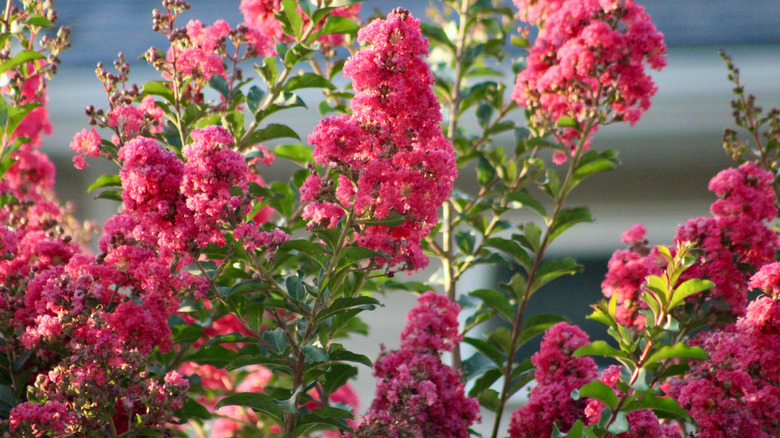How To Grow Crepe Myrtle Trees In Containers To Add Showstopping Beauty To Your Patio
Flowering trees can transform a dull patio into an at-home oasis, and bring a sense of tranquility to your backyard. However, if you aren't ready to fully commit to planting a tree directly into the ground, growing one in a container garden can be a stunning and practical alternative. Crepe myrtles (Lagerstroemia indica) are an ideal tree to grow in container-style gardens. This deciduous tree native to Asia thrives in pots and containers with good drainage.
The crepe myrtle gets its name from its delicate, paper-like flowers that bloom in vibrant shades of pink, red, and purple. These easy to grow trees are both heat and drought resistant, and are fast growing and easy to propagate. If you're looking to attract pollinators for more biodiversity, the 'Twilight' crepe myrtle species is a hummingbird magnet. However, crepe myrtles are not winter tolerant, and one benefit of growing them in a container is the ability to bring them indoors for colder months. Especially if you live outside of the crepe myrtles USDA zones — 6 through 10. The tree requires lots of sunlight, so growing it in a pot also allows you to choose an ideal, sunny location you might not have been able to plant in, like a porch or walkway. With that said, there are some must-know care tips to ensure a thriving crepe myrtle tree, especially when choosing to grow your tree in a container.
Growing and caring for crepe myrtles in containers
The first step to growing your crepe myrtle in a container is making sure your pot is big enough to accommodate the tree's growth. The container will also need holes in the bottom for good drainage, and have enough room enough to accommodate the tree's root ball without being too cramped. Choose a location that gets at least six hours of full sunlight a day. While crepe myrtles can tolerate partial shade, trees that receive less sun yield fewer flowers. Crepe myrtles in containers also need more frequent watering than those planted in the ground, and they like damp, but not overly wet soil. In general, crepe myrtles don't require a lot of fertilizing to thrive, and are self-sufficient. However, when growing in containers, you can give them an extra boost in the spring by applying light amounts of organic fertilizer.
Regular pruning can help prevent your tree from getting too big for its container. The best time of year to trim a crepe myrtle is late winter to early spring. It's also best to let the tree keep its natural shape and only remove small or dead branches, and to avoid over-pruning or stunting your crepe myrtle. Crepe myrtles are both gorgeous and easy to care for, making them an excellent candidate to brighten up your yard, porch, or patio.

